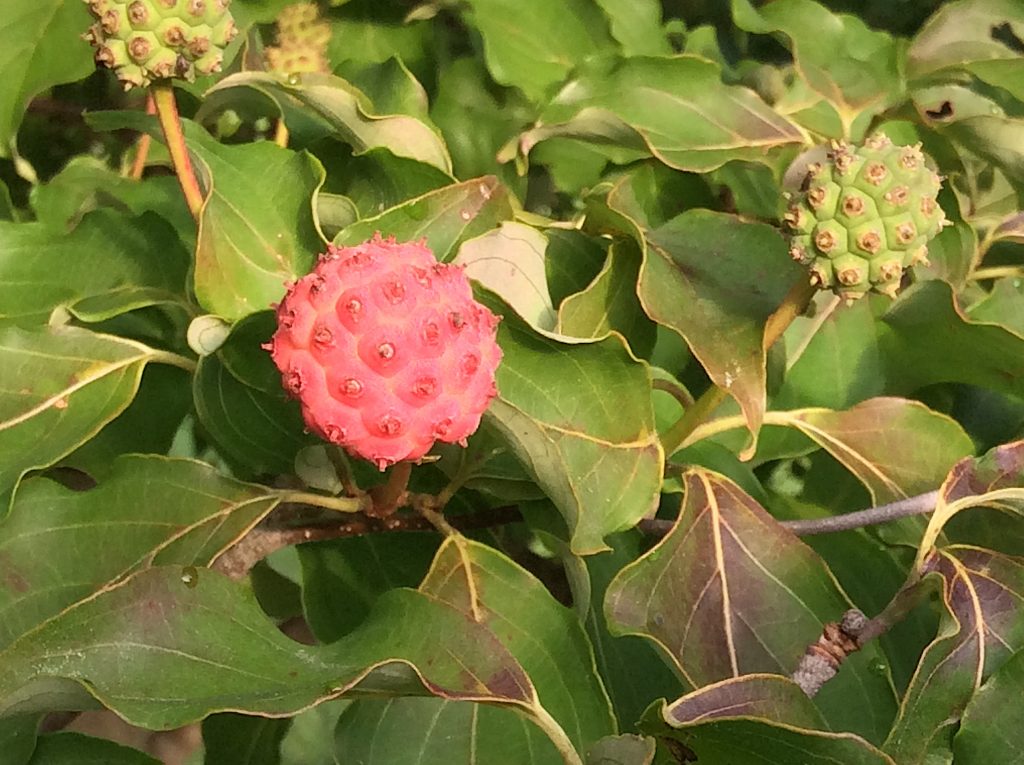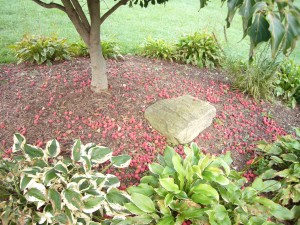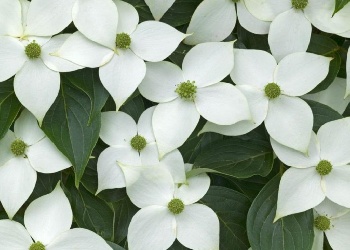
Ripe and unripe Kousa Dogwood fruit. Photo by Green Deane
Cornus kousa: A Dog-gone-good Dogwood
The Kousa Dogwood is one of those plants that makes you ask: What is it?
Its large, bumpy, red fruit looks like a raspberry on steroids. Very eye catching and exotic, which it is in North America. Planted as an ornamental reports say it is naturalized only in the New York city area. But I have personally seen it growing on its own from there south and west. You can also find it in protected or warmer areas farther north. Look for it in landscaping or as a potted plant. In the Carolinas, where I go for a busman’s holiday, it’s a common ornamental. In fact where I stay in Boone, North Carolina, there’s one at the bottom of the hill. In Ashville where I study mushrooms it’s an escapee. In late August it and the ground beneath it are covered with fruit.
The Kousa grows to 15 to 20 feet, has flakey bark, and long-lasting white “flowers” which usually come out about a month after its cousin, the Flowering Dogwood (Cornus florida.) Actually, its flowers are quite small. The shrub’s showiness comes from large white bracts that dwarf the true flowers. The bracts are two to three inches across, sometime off-white to light yellow, and cover the entire tree when in bloom. Another reason why this Asian native is used in landscaping is as it matures the bark flakes leaving a camouflage pattern of tan and brown, sometimes tan and green. In autumn the leaves turn bronze before dropping.
Kousa’s bracts can turn pink to red through the season, and the Cornus kousa satomi starts with pink flowers that turn purple. In fact, there are nearly 100 different cultivars of the plant and it’s been in western gardens since 1875. The Kousa is also resistance to Dogwood Anthracnose, a fungal disease that has been infecting flowering dogwoods in eastern North America.
Although the fruit is pink to red, inside it is yellow to orange and has a taste people can’t agree on. Some say the texture similar to a pear or apricot. To me the pulp texture was like a ripe persimmon, the flavor like an apple. The tougher skin tasted like bitter peach. Usually it is eaten raw but can be cooked but doing so can destroy its delicate flavor. The fruit can also be made into jelly. As I said the skin can be tough and sometimes the fruit is bitter. The young leaves are cooked and eaten by mountain people in Japan. I have not tried said, so be wary. Additionally, the fruit may have anti-tumor activity. Read the Herb Blurb below. It ain’t easy…
Botanically Cornus (KORE-nus) means “horn” which can mean a wind instrument or hard. The dogwood is known to make stiff skewers and dogwood is from Dag where we also get the word dagger. Kousa (KOO-sah) is the Japanese name for the tree, It is also called Benthamia kousa – (Miq.) Nakai, and Benthamidia japonica (Siebold.&Zucc.) H.Hara.
Green Deane’s “Itemized” Plant Profile
IDENTIFICATION: Shrub or a small tree to 25 feet, camouflaged-patterned bark, tan and brown, leaves 2 to 4″ long, opposite, simple, dark green; reddish purple to scarlet to bronze fall color. Vase shaped when young growing into a rounded shape with horizontal branching.
TIME OF YEAR: Fruit in the fall, young leaves anytime present.
ENVIRONMENT: Well-drained soil, full sun to partial shade, usually in landscaping or potted.
METHOD OF PREPARATION: Ripe fruit edible raw. They can be made into jelly. Young leaves boiled.
HERB BLURB
20 May 2005, Life Sciences, Volume 78, Issue 7, pp 777-784: The anthocyanins in native Cornus alternifolia, Cornus controversa, Cornus kousa and Cornus florida were quantified by HPLC and characterized by spectroscopic methods. The analyses of C. alternifolia and C. controversa revealed that both contained delphinidin 3-O-glucoside (1), delphinidin 3-O-rutinoside (2) and cyanidin 3-O-glucoside (6), respectively. Similarly, C. florida and C. kousa showed identical anthocyanin profiles with major anthocyanins as cyanidin 3-O-galactoside (4) and cyanidin 3-O-glucoside (6), respectively. The amount of anthocyanins 1, 2 and 6 in C. alternifolia and C. controversa were 8.21, 8.44 and 0.02 mg; and 7.74, 5.92, and 0.02 mg/g of fresh fruits, respectively. The anthocyanins 4 and 6 in C. kousa and C. florida were 0.02 and 0.16 mg; and 0.62 and 0.03 mg/g fresh fruits, respectively. Anthocyanins 1 and 2 were not studied earlier for their inhibition of lipid peroxidation, cyclooxygenase enzymes (COX-1 and COX-2), and tumor cell proliferation. At 50 μg/mL, anthocyanins 1 and 2 inhibited lipid peroxidation by 71% and 68%, respectively. Similarly, they inhibited COX-1 enzymes by 39% and 49% and COX-2 enzyme by 54% and 48%, respectively, at 100 μg/mL. Anthocyanin 1 displayed 50% growth inhibition (IC50) at 21, 25, 50, 60, and 75 μg/mL, against HCT-116 (colon), MCF-7 (breast), NCI-H460 (lung), SF-268 (central nervous system CNS), and AGS (stomach) human tumor cell lines, respectively. Similarly, IC50 values for anthocyanin 2 were 38, 30, 76, 100, and 100 μg/mL against HCT-116, MCF-7, NCI H460, SF-268, and AGS, respectively. This is the first report of the quantification and biological activities of anthocyanins in C. alternifolia, C. kousa and C. florida in addition to the anthocyanins not previously quantified in C. controversa.




Do you have an article on Stiff Dogwood Cornus foemina? Anything edible on that one? Thanks.
I have no reference to Cornus foemina being used for anything except perhaps arrow shafts.
Can the fruit from a Kousa Dogwood tree be planted to produce a new tree and if so when should it be planted in Tennessee???
Yes and yes but the seeds need to be put through a particular process to make them germinate. Best look it up.
I love this plant. The fruit is only semi-desirable but its real good looking and the interior of the fruit is quite good, tho a bit insipid at times. My biggest problem with mine is that while nothing overhangs it, it does lean significantly south. I would prefer it to be more symmetrical and straight. Mine is very big and not planted in the right spot, but I didn’t put it there and it provides abundant berries yearly or bi-yearly (possibly coinciding with the years the bird feeder is on that tree during winter). I find the best way to eat the fruits is probably to spit the skin. Just pop the whole thing in the mouth, suck out the pulp and spit out the skin and pit. The whole fruiting tree looks alien to me, the flower and fruit both look like they are from Mars. When I first moved here I was struck by how pronounced they were and how awesome they looked in spring and autumn mists.
I have this wonderful tree in my back yard for almost 10 years now. It fives wonderful “flowers” which I enjoy from my kitchen window, my desk and yard. The fruit I look forward to. It is true it is “sandy” but then it is a nice experience for me. However in all the years I have had this tree and as many dropped fruit it has made, it has never produced a baby tree. I have tried to freeze the seeds and make new baby trees with no luck. Perhaps someone out there has done this. I would love to know how. Thanks
We have several trees on our property.Some were purchased & others were
” babies” from a friend. We have many seedlings sprout spontaneously. We have given several ” babies” which I had moved after finding it in the lawn to safer sites. They grow reasonably fast once separated. No need for special preparations. You may want to bury several plump seeds in an open area to insure germination. Good luck. Birds in our area love these fruits, so do the little rodents!
I have a Pink Flowering Dogwood I just planted this early Spring. It was doing very well until the heat set in and it is wilting and looks dry. I keep it watered so It is not that. Help please
I have many Pink and White Dogwood trees that are lush and produce many fruit. Not brave enough to eat the fruit, maybe some day though. This summer we had many days of Sun and temps 90+. I took extra care in watering every day and once a month I’d sprinkle triple 18 fertilizer under the tree. About every two months I use Superthrive as well. Excellent stuff. Good luck and enjoy your new tree.
Dear Dog wood lovers, I had to cut down a 70′ perfectly healthy matching maple tree here at my 300 year old home, in order to add the new Edwardian Conservatory…I cried when the tree men came and cut it down, but it made good fire wood for our 5 fireplaces. Unknowingly, I chose a “Japanese Dog Wood” to add some “nature” to the concrete and hard scape of the now barren corner. Today I found it’s name as a Kousa Dog wood, and I curse it every day for the sharp (half chewed by squirrels) pieces that line the walk way to the swimming pool….it’s a killer on bare feet. Nice to know it’s edible. I’ll try it.
Do you have the red berries this year?
You say that the tree is planted in an area of “concrete and hardscape”. Those berries will drive you bananas on pathways and concret. Some years you will be picking them up by the pound three, four, five times a day for three weeks unless of course you don’t mind an ant colony’s delight of smashed berry piles around your home. I have to try to pick them up early in the day so that the schoolkids don’t have to walk on them, mid-day so visitors and delivery people don’t, and evenings … you get the idea. If it won’t break the bank you might consider changing the tree out. A slow growing attractive conifer or maple might be nice. I regret not changing mine out a long time ago.
Have you ditched the husband, too?
haha No. He’s a keeper! The Cornus florida would’ve likely been a different sort of problem because the spot would be wrong for a tree with that height potential and in this area (southeastern PA) we lost many to a disease/virus (can’t remember which right now) going back more than 10 years now. I love the look of our dogwood and every year I decide to keep it in spite of the issues but she does belong on a different site. She’s got a beautiful form and the peeling bark was a very happy surprise to us when she matured. However, I’ve rolled my ankle a many times on the springtime hard green remnants of the flowers that Carole mentioned. These red berries … oh those berries! I have a contractor trash bag with more than 5 pounds collected last night and so far today.
I live in Gaithersburg Maryland, and found these (uh) cherry things but bumpy. I’m 99% sure they are from the Kousa Dogwood.
There are still many on the tree. Edibility ? Just tell me they are not toxic;/ Oh, btw, did Indians smoke the ? (beans) from the Catalpa tree ?
p.s. I’m no botanist !
I’ve have a Cornus kousa growing in my front garden for 20+ years. She was a gift from my husband (I’d actually wanted a Cornus florida). Those frankenberries are a messy nuisance. I tasted them once out of curiousity but I am not a fan of the soft & gritty texture or the bland flavor. The squirrels and ants love the berries (of course they do) and if I find out she’s feeding the darn mice she will be featured in the next bonfire. We have a bumper crop this year! Why by the time this harvest is done I will have the best toned thighs on the block. If any of you folks would like some please come on over and have at ’em for free.
These are very unusual.i saw one outside my school and wondered what it was.happy to find its not poisonous!
I discovered a plant of the tree at Riderwood Village recently and was curious about it. At first sight, I thought it was a Lychee plant. Being curious I picked a fruit from the tree to ascertain what it was and origin. Eventually the fruit was identified and the plant. I found the fruit to be quite tastety.
I discovered four trees in a commercial area in Laurel, Md. They are beautiful for landscaping! Curious about what they were, I picked two berries and took to my daughter whom I was sure could identify them. She wasn’t sure and identified them through your website. Interestingly, two trees were plentiful with the berries, two had none. Do these trees, like some pear trees I have, pollinate each other? I did not taste the berry but my son-in-law did, and found it to be “not bad…but not good either.” I am almost 70 years old and have always been interested in trees, plants, nature, etc., and thoroughly enjoy finding something new. Thank you for your website and the opportunity to find more information about my discoveries!
I take care of a garden where this tree was planted as an ornamental. I have to keep it lightly pruned for room for growing flowers under it. It is in a very windy and dry location. It is always beautiful. I can’t wait to try eating the fruits, especially since there are tons of them every year. I leave most of the fruits on the ground under it for more mulch. The tree is easy to propagate. I am forever pulling out little trees that grow under it. That is my biggest effort in caring for the tree.
Are there any poisonous lookalikes comparable to this plant?
Hi! Thank you for the amazing info. We have some beautiful dogwood fruit ripening in my neighborhood right now. I’m wondering… Can I put the whole fruit in my blender and puree it that way? In other words, is the seed edible?
Thanks!
I believe the seed is inedible and bad tasting. I planted one last year and am pleased with the star like flowers. Have yet to get the first fruit.
Are the dogwood flowers edible and do they make a good tea? There are so many flowers, it would be great to have an endless supply of them, :)!
I am interested in the anthocyanin properties of Kousa berries with respect to antineoplastic, anti-inflammatory, antibacterial activity. The above citation gave a little insight, but I’m looking for something more indepth. I’m still looking for side effects and toxic worries with consumption of these berries. Can anyone provide this information, please. Thank you.
How about tapping into it for water or syrup. I am going to attempt a freezer jam out of it this year……. such a pretty tree
I found what I think is a dogwood in my yard. The strange thing is I never noticed it before today when I saw red fruit on it. I searched online and it looks like a Kousa Dogwood however, the leaves instead of being smooth on the edges, has more of a sawtooth around the whole edge. The fruit looks like large raspberries. Just curious if I have a dogwood or some other type of tree.
My first encounter with one of these was along the Potomac Bike Trail below Washington, DC.. When I saw it, I, too, thought it was lychee, but after opening one up I knew better. My wife gasped when she saw me tasting it, and it was delicious. I’ve since seen a few of these here in southeast Ohio near my dad’s house and got the chance to enjoy them again. I don’t think the neighbors know what they have.
Grows all over the great Pacific NorthWET
(no typo – ? ).
Use them in my juicers. Fantastic!
I first saw cornus kousa (aka Kuza) in Asheville NC earlier this year. I’ve identified 3 of them in Rossmoor, Walnut Creek CA. I picked up a bunch of falls and I’m disappointed you don’t have a recipe for jam!
can the flowers be made into jelly? I make jelly from wild bradford pears, beauty berries, redbuds and many other flowers. I am very interested in dogwood flowers this year as they will be blooming in the next week or so here.
I have always been acutely interested in all types of plants, so I am enjoying your site,
Does anyone know if the seeds are ok to eat?
My daughters gave me a gift certificate for mother’s dY and I am now the proud owner of a Japanese Kousa Dogwood. So glad I found this sight. Has anyone planted their tree in a pot then put it in the ground the following spring. If so, what were the results?
Thanks
I live on Cape Cod in Massachusetts. I have 2 mature kousa dogwoods in my front yard near the street. They are producing the most spectacular display of fruit I’ve ever seen on them. The climate here is very cold in the winter, but we have warm summers, and this year a lot of rain. Apparently they like their home.